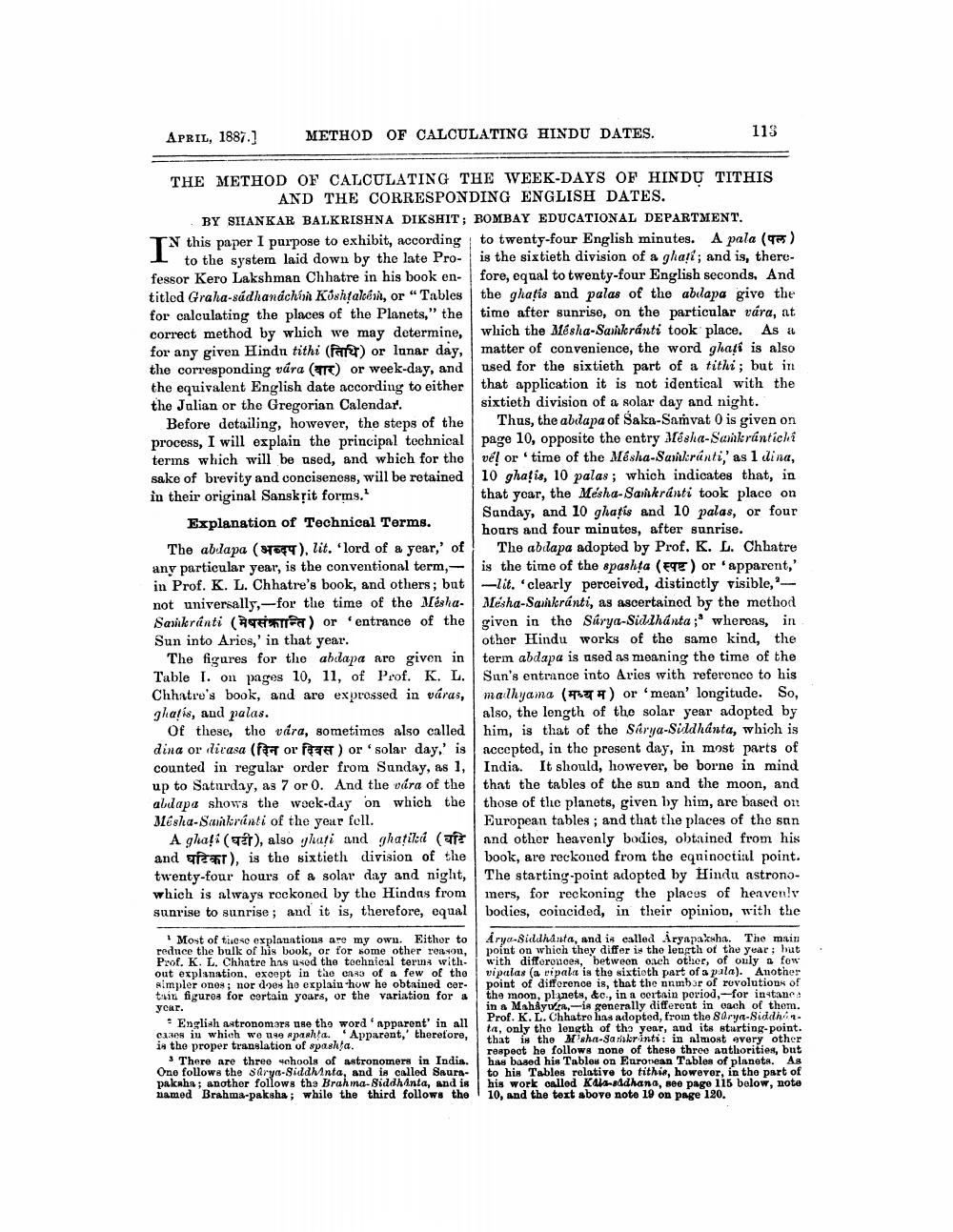________________
APRIL, 1887.]
METHOD OF CALCULATING HINDU DATES.
113
THE METHOD OF CALCULATING THE WEEK-DAYS OF HINDU TITHIS
AND THE CORRESPONDING ENGLISH DATES. BY SIIANKAR BALKRISHNA DIKSHIT; BOMBAY EDUCATIONAL DEPARTMENT, TN this paper I purpose to exhibit, according to twenty-four English minutes. A pala (te) 1 to the system laid down by the late Pro- is the sixtieth division of a ghali; and is, therefessor Kero Lakshman Chhatre in his book en- fore, equal to twenty-four English seconds, And titled Graha-sádhandchi Kóshtalai, or " Tables the ghațis and palas of the abılapa give the for calculating the places of the Planets," the time after sunrise, on the particular vára, at correct method by which we may determine, which the Mesha-Sankranti took place. As a for any given Hindu tithi (fare) or lunar day, matter of convenience, the word ghati is also the corresponding vára (TTC) or week-day, and used for the sixtieth part of a tithi; but in the equivalent English date according to either that application it is not identical with the the Julian or the Gregorian Calendar.
sixtieth division of a solar day and night. Before detailing, however, the steps of the Thus, the abiapa of Saka-Samvat 0 is given on process, I will explain the principal technical page 10, opposite the entry Blésha-Sankrantichi terms which will be used, and which for the vel or time of the Mésha-Sankranti,' as 1 dina, sake of brevity and conciseness, will be retained 10 ghatis, 10 palas; which indicates that, in in their original Sanskrit forms.!
that year, the Mesha-Sankránti took place on
Sunday, and 10 ghatís and 10 palas, or four Explanation of Technical Terms.
hours and four minutes, after sunrise. The abdlapa (87644), lit. 'lord of a year,' of The abdapa adopted by Prof. K. L. Chhatre any particular year, is the conventional term, - is the time of the spashta (FIE) or 'apparent,' in Prof. K. L. Chhatre's book, and others; but --lit. clearly perceived, distinctly visible, not universally,--for the time of the Mesha-Mesha-Sankránti, as ascertained by the method Saikránti (ATH ) or entrance of the given in the Súrya-Siddhanta ;' wheroas, in Sun into Arios,' in that year.
other Hindu works of the same kind, the The figures for the abdapa are given in term abdapa is used as meaning the time of the Table I. on pages 10, 11, of Prof. K. L. Sun's entrance into Aries with reference to his Chhatre's book, and are expressed in varas, malhyama ( TH) or mean' longitude. So, ghalis, and palas.
also, the length of the solar year adopted by Of these, the vara, sometimes also called him, is that of the Sarya-Siddhanta, which is dina or dirasa (ft or fata) or solar day.' is accepted, in the present day, in most parts of counted in regular order from Sunday, as 1, India. It should, however, be borne in mind up to Saturday, as 7 or 0. And the vara of the that the tables of the sun and the moon, and aldapa shows the week-day on which the those of the planets, given by him, are based on Mésha-Sankrinti of the year fell.
European tables; and that the places of the san A ghaļi (ér), also yluati and ghatili (aft and other heavenly bodies, obtained from his and aft ), is the sixtieth division of the book, are reckoned from the equinoctial point. twenty-four hours of a solar day and night, The starting point adopted by Hindu astronowhich is always rockoned by the Hindas frommers, for reckoning the places of heavenly sunrise to sunrise ; and it is, therefore, equal bodies, coincided, in their opinion, with the
Most of these explanations are my own. Either to reduce the bulk of his book, or for some other reason, Prof. K. L. Chhatre has used the tochnical terms with
with difebuch they differ
nos nor does he extense of them with
simpler ones; nor do ho explaiu 'how he obtained cer- tuin figures for cortain yours, or the variation for & your.
• English astronomars use the word ' apparent' in all 0.130s in which we use apashta. Apparent,' therefore, in the proper translation of spasha.
There are three chools of astronomers in India. Ono follows the sdryn-Siddhanta, and is called Saurapakahs; another follows the Brahma-Siddhanta, and is named Brahma-paksha; whilo the third follows the
Aryo-Siddhanta, and is called Aryapaksha. The main point on which they differ is the length of the year; but with differences between each other, of ouly = fow vipalas (a eipala is the sixtioth part of a pala). Another point of difference is, that the number of rovolutions of the moon, planets, &c., in a certain poriod, for instance in a Maháyuta, in generally different in each of them. Prof. K. L. Chhatre has adopted, froin the 8 ryn-Siddhin. ta, only the length of tho your, and its starting point. that is the M'sha-Saraler inti: in almost every other respect he follows none of these three authorities, but has based his Tablow on Furonean Tables of planeta. As to his Tables relative to tithin, however, in the part of his work oallod Kiddhana, seo page 115 bolow, note 10, and the text above note 19 on page 120.




